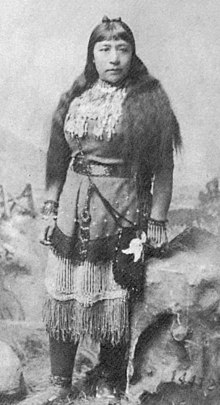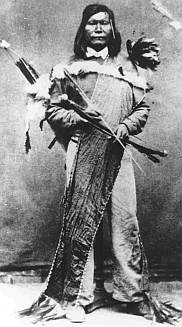Paiute: Difference between revisions
m BOT - rv 205.127.86.4 (talk) to last version by Thijs!bot |
m →Northern Paiute: "XL Ranch", not "XL Rancheria" |
||
| Line 33: | Line 33: | ||
* Yerington Paiute Tribe - [[Yerington, Nevada]] |
* Yerington Paiute Tribe - [[Yerington, Nevada]] |
||
* Fort Bidwell - [[Fort Bidwell Indian Reservation]] (California) |
* Fort Bidwell - [[Fort Bidwell Indian Reservation]] (California) |
||
* XL |
* XL Ranch - [[Alturas, California]] |
||
Famous Northern Paiutes: |
Famous Northern Paiutes: |
||
Revision as of 18:54, 18 April 2007

Paiute (sometimes written Piute) refers to two related groups of Native Americans — the Northern Paiute of California, Nevada and Oregon, and the Southern Paiute of Arizona, southeastern California, and Nevada, and Utah, who spoke languages belonging to the Numic branch of the Uto-Aztecan family of Native American languages. The use of the name "Paiute" for these peoples is misleading. The Northern Paiute are more closely related to the Shoshone than to the Southern Paiute; the Southern Paiute are more closely related to the Ute than to the Northern Paiute. Usage of the terms Paiute, Northern Paiute and Southern Paiute is most correct when referring to groups of people with similar language and culture, and should not be taken to imply a political connection or even an especially close genetic relationship.
The origin of the word Paiute is unclear. Some anthropologists have interpreted it as "Water Ute" or "True Ute." The Northern Paiute call themselves Numa (sometimes written Numu); the Southern Paiute call themselves Nuwuvi. Both terms mean "the people." Early Spanish explorers called the Southern Paiute "Payuchi" (they did not make contact with the Northern Paiute). Early Euro-American settlers often called both groups of Paiute "Diggers" (presumably due to their practice of digging for roots), although that term is now considered derogatory. The Northern Paiute are sometimes referred to as "Paviotso."
The Bannock, Mono, Panamint and Kawaiisu people, who also speak Numic languages and live in adjacent areas, are sometimes referred to as Paiute.
The Northern Paiute speak the Northern Paiute language, while the Southern Paiute speak the Ute-Southern Paiute language. These languages are not as closely related to each other as they are to other Numic languages.
Northern Paiute
The Northern Paiute traditionally lived in the Great Basin in eastern California, western Nevada, and southeast Oregon. The Northern Paiute's pre-contact lifestyle was well adapted to the harsh desert environment in which they lived. Each tribe or band occupied a specific territory, generally centered on a lake or wetland that supplied fish and water-fowl. Rabbits and pronghorn were taken from surrounding areas in communal drives, which often involved neighboring bands. Individuals and families appear to have moved freely between bands. Pinyon nuts gathered in the mountains in the fall provided critical winter food. Grass seeds and roots were also important parts of their diet. The name of each band came from a characteristic food source. For example, the people at Pyramid Lake were known as the Cui Ui Ticutta (meaning "Cui-ui eaters"), the people of the Lovelock area were known as the Koop Ticutta (meaning "ground-squirrel eaters") and the people of the Carson Sink were known as the Toi Ticutta (meaning "tule eaters").

Relations among the Northern Paiute bands and their Shoshone neighbors were generally peaceful. In fact the distinction between the Northern Paiute and Western Shoshone is not sharp. Relations with the Washoe people, who were culturally and linguistically very different, were not so peaceful.

Sustained contact between the Northern Paiute and Euro-Americans came in the early 1840s, although the first contact may have occurred as early as the 1820s. Although they had already started using horses, their culture was otherwise largely unaffected by European influences at that point. As Euro-American settlement of the area progressed, several violent incidents occurred, including the Pyramid Lake War of 1860 and the Bannock War of 1878. These incidents took the general pattern of a settler steals from, rapes or murders a Paiute, a group of Paiutes retaliate, and a group of settlers or the US Army counter-retaliates. Many more Paiutes died from introduced diseases such as small pox. Sarah Winnemucca's book "Life Among the Piutes"[1] gives a first-hand account of this period, although it is not considered to be wholly reliable.
The first reservation established for the Northern Paiute was the Malheur Reservation in Oregon. The federal government's intention was to concentrate the Northern Paiute there, but its strategy didn't work. Due to the distance of that reservation from the traditional areas of most of the bands, and due to the poor conditions on that reservation, many Northern Paiute refused to go there and those that did soon left. Instead they clung to the traditional lifestyle as long as possible, and when environmental degradation made that impossible, they sought jobs on white farms, ranches or cities and established small Indian colonies, where they were joined by many Shoshone and, in the Reno area, Washoe people. Later, large reservations were created at Pyramid Lake and Duck Valley, but by that time the pattern of small de facto reservations near cities or farm districts often with mixed Northern Paiute and Shoshone populations had been established. Starting in the early 1900s the federal government began granting land to these colonies, and under the Indian Reorganization Act of 1934 these colonies gained recognition as independent tribes.

These are federally recognized tribes with significant Northern Paiute populations:
- Bridgeport Paiute Indian Colony - Bridgeport, California
- Burns Paiute Tribe - Burns, Oregon
- Fallon Paiute-Shoshone Tribe - Fallon, Nevada - (The Fallon Indian Reservation is also known as Stillwater)
- Fort McDermitt Paiute and Shoshone Tribe - Fort McDermitt Indian Reservation (Nevada and Oregon)
- Fort Hall Indian Reservation, 544,000 acres (2,201 km²) in South Eastern Idaho. Lemhi and Northern Shoshone tribes with the Paiute tribe, the Bannock Indians
- Lovelock Paiute Tribe - Lovelock, Nevada
- Pyramid Lake Paiute Tribe - Pyramid Lake Indian Reservation (Nevada)
- Reno-Sparks Indian Colony - Reno, Nevada
- Shoshone-Paiute Tribes of the Duck Valley Reservation - Duck Valley Indian Reservation (Nevada and Idaho)
- Summit Lake Paiute Tribe - Summit Lake Indian Reservation (Nevada)
- Walker River Paiute Tribe - Walker River Indian Reservation (Nevada)
- Winnemucca Colony - Winnemucca, Nevada
- Yerington Paiute Tribe - Yerington, Nevada
- Fort Bidwell - Fort Bidwell Indian Reservation (California)
- XL Ranch - Alturas, California
Famous Northern Paiutes:
- Poito (Chief Winnemucca)
- Sarah Winnemucca
- Wovoka (Jack Wilson)
- Chief Tenaya Leader of the Ahwahnees
- Numaga
- Ochio
- Truckee
- Captain John - Shibana or Poko Tucket
- Joaquin
Population
Estimates for the pre-contact populations of most native groups in California have varied substantially. (See Population of Native California.) Alfred L. Kroeber (1925:883) thought that the 1770 population of the Northern Paiute within California was 500. Catherine S. Fowler and Sven Liljeblad (1978:457) put the total Northern Paiute population in 1859 at about 6,000.
Kroeber estimated the population of the Northern Paiute in California in 1910 as 300.
Southern Paiute

The Southern Paiute traditionally lived in the Colorado River basin and Mojave Desert in northern Arizona, southeastern California, southern Nevada, and southern Utah. The Utah Paiutes were terminated in 1954 and regained federal recognition in 1980. A band of Southern Paiutes at Willow Springs and Navajo Mountain, south of the Grand Canyon, reside inside the Navajo Indian Reservation. These "San Juan" Paiutes were recognized by the Bureau of Indian Affairs in 1980.
First European contact with the Southern Paiutes occurred in 1776 when Fathers Silvestre Vélez de Escalante and Francisco Atanasio Domínguez chanced upon them during their failed attempt to find an overland route to the missions of California. In 1851, Mormon settlers strategically occupied Paiute water sources, which created a dependency relationship.
Southern Paiute communities are located at Las Vegas, Pahrump, and Moapa, in Nevada; Cedar City, Kanosh, Koosharem, Shivwits, and Indian Peaks, in Utah; at Kaibab and Willow Springs, in Arizona; and at Death Valley and Chemehuevi on the Colorado River in California. Some would include the 29 Palms Reservation in Riverside County, California.
Pah Ute War

The Pah Ute War, also known as the Paiute War, was a minor series of raids and ambushes initiated by the Native American tribe, the Paiute, that had an effect on the development of the Pony Express. It took place from May through June of 1860, though sporadic violence continued.
See also
- Northern Paiute traditional narratives
- Mountain Meadows Massacre
- History of the Yosemite area
- Hetch Hetchy Valley
- Mono Lake
- Pyramid Lake
References
- Fowler, Catherine S., and Sven Liljeblad. 1978. "Northern Paiute". In Great Basin, edited by Warren L. d'Azevedo, pp. 435-465. Handbook of North American Indians, William C. Sturtevant, general editor, vol. 11. Smithsonian Institution, Washington, D.C.
- Kroeber, A. L. 1925. Handbook of the Indians of California. Bureau of American Ethnology Bulletin No. 78. Washington, D.C.
Notes
- ^ Hopkins, Sarah Winnemucca (1883).
Life Among the Piutes: Their Wrongs and Claims. Full text online.
